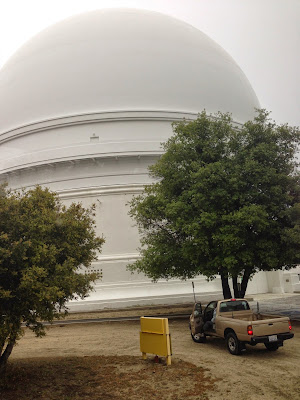Last month, I visited the Mojave Desert, near Barstow, on a field trip for my geology class this term. We mapped a section of Rainbow Basin, pictured above. This area, which is now in the high desert, used to be the site of a lake! How do I know this?
The first clue is the rocks. Although the outcrop shows they have experienced a massive folding event, these rocks were originally deposited in horizontal layers. They are sedimentary rocks--made up of smaller rock particles that were compacted together over time. Using a hand lens to look at the individual grains, they are revealed to be very tiny clay particles. Because clay is so light, even the slightest of river currents can pick it up and transport it. The fact that this clay was deposited and later became a rock indicates that these rocks formed in a very low-energy environment. That suggests the rocks formed in the bottom of a large body of water.
Looking at the surfaces of exposed layers shows something telling--ripple marks! They can be found throughout the formation. You can imagine how these ripple marks might have formed at the edge of the water where waves lapped against the shore. Closer examination can even reveal the direction of the currents. Symmetrical ripples suggest wave action. Asymmetrical ripples suggest unidirectional flow. I found both types.
Here and there in the rock record, lake sediments are interspersed with a volcanic material called tuff. Tuff is volcanic ash that has been fused together into a rock. Because the ash is so light, wind can carry tuff very far, so it is not suspected that there were any volcanoes in the vicinity of the lake. But the tuff serves as a "marker bed" that differentiated between different layers of rock, and can provide a time estimate for the age of the rocks above and below it.
In one of these marker beds, I found inverted mud cracks. They look like casts of ordinary mud cracks, the kind you might find in a dried out pond today. I can imagine clearly what must have happened. The lake must have gone through a dry spell, and as water evaporated, cracks formed in the newly exposed sediment. Then, a thick layer volcanic ash was deposited, and filled in the cracks, forming a new layer in the formation. The inverted cracks still give a sense of orientation to the landscape--they tell us where the surface used to be--even though the original mud cracks are long gone.
Next, we visited Pisgah Crater in the Lavic Lake volcanic field. Looking around at the landscape, it is easy to see this area is a very different environment from Rainbow Basin.
For one thing, the rocks are very dark! This is because they are basaltic, similar in composition to fresh lava seen in Hawai'i today. The lava has a ropy texture, called pahoehoe, a word that comes from Hawaiian. It forms when an insulating crust of lava cools on the top of the rest of the flow, but continues to be pushed along by the motion below. This insulation actually allows the lava to stay hot underneath the crust and allows lava to continue to flow for much longer than it would have otherwise. It also creates lava tubes that are fantastic to explore.
Standing at the peak, you can easily see where lava flows have covered the desert valley below. The dark basaltic rocks provide a heavy contrast to the bright desert rocks.
Pisgah is a cinder cone volcano. It's relatively young, so it has no connection to the tuff layers in Rainbow Basin. Although we don't normally think of Southern California as a major site of volcanoes, the famous San Andreas fault undergoes extensional motion in this region. The motion creates a rift zone where volcanoes formed by upwelling magma can dot the surface.

























